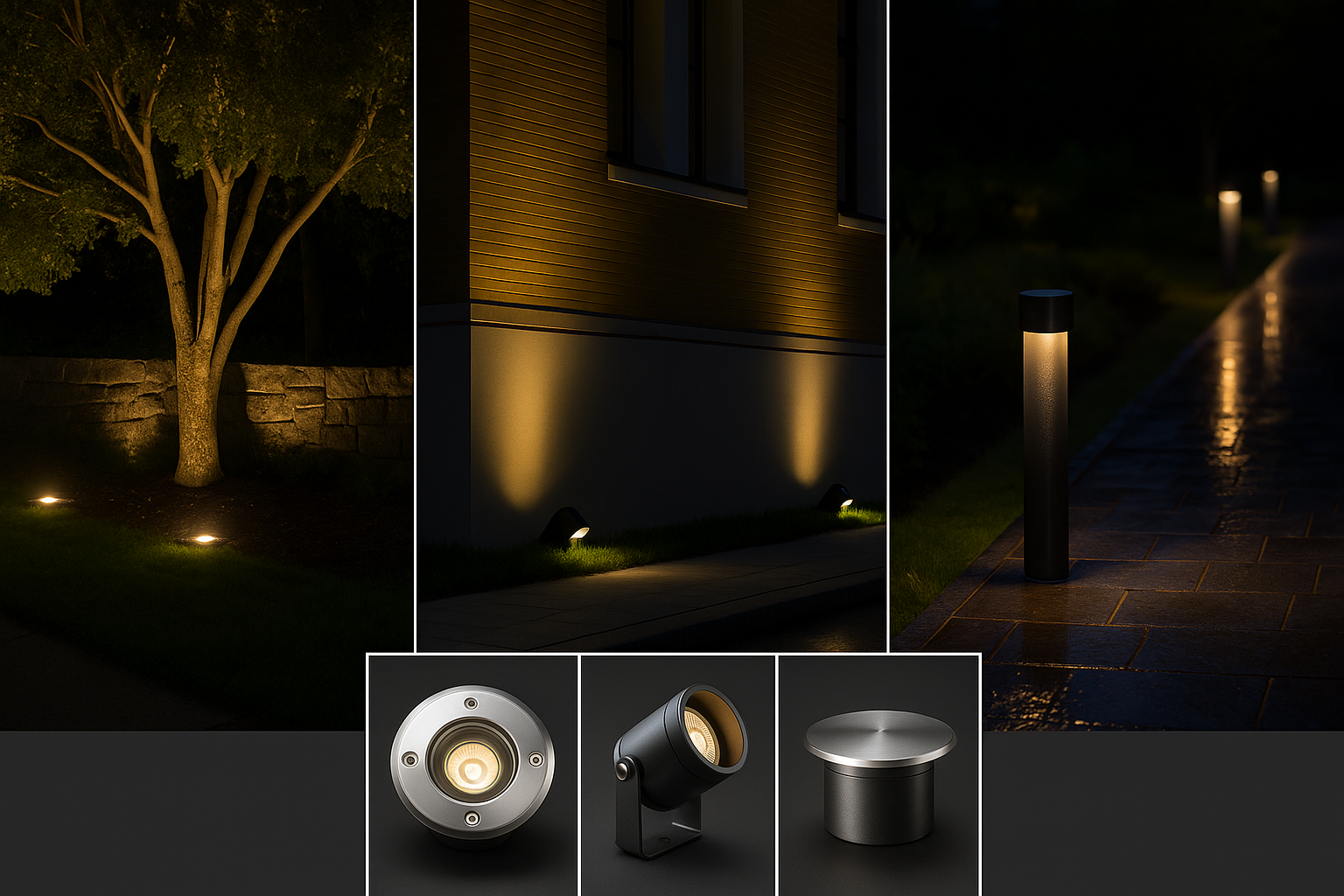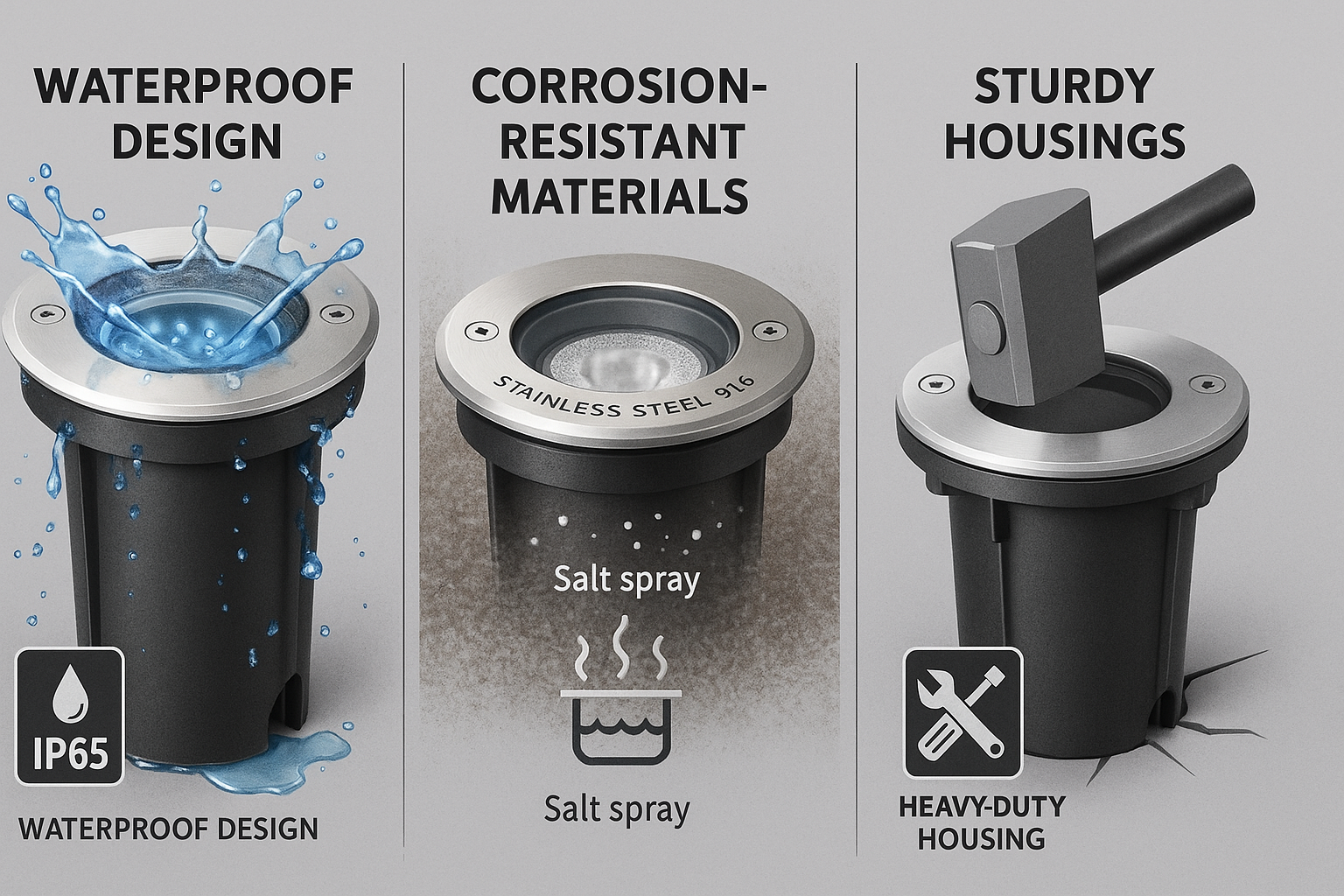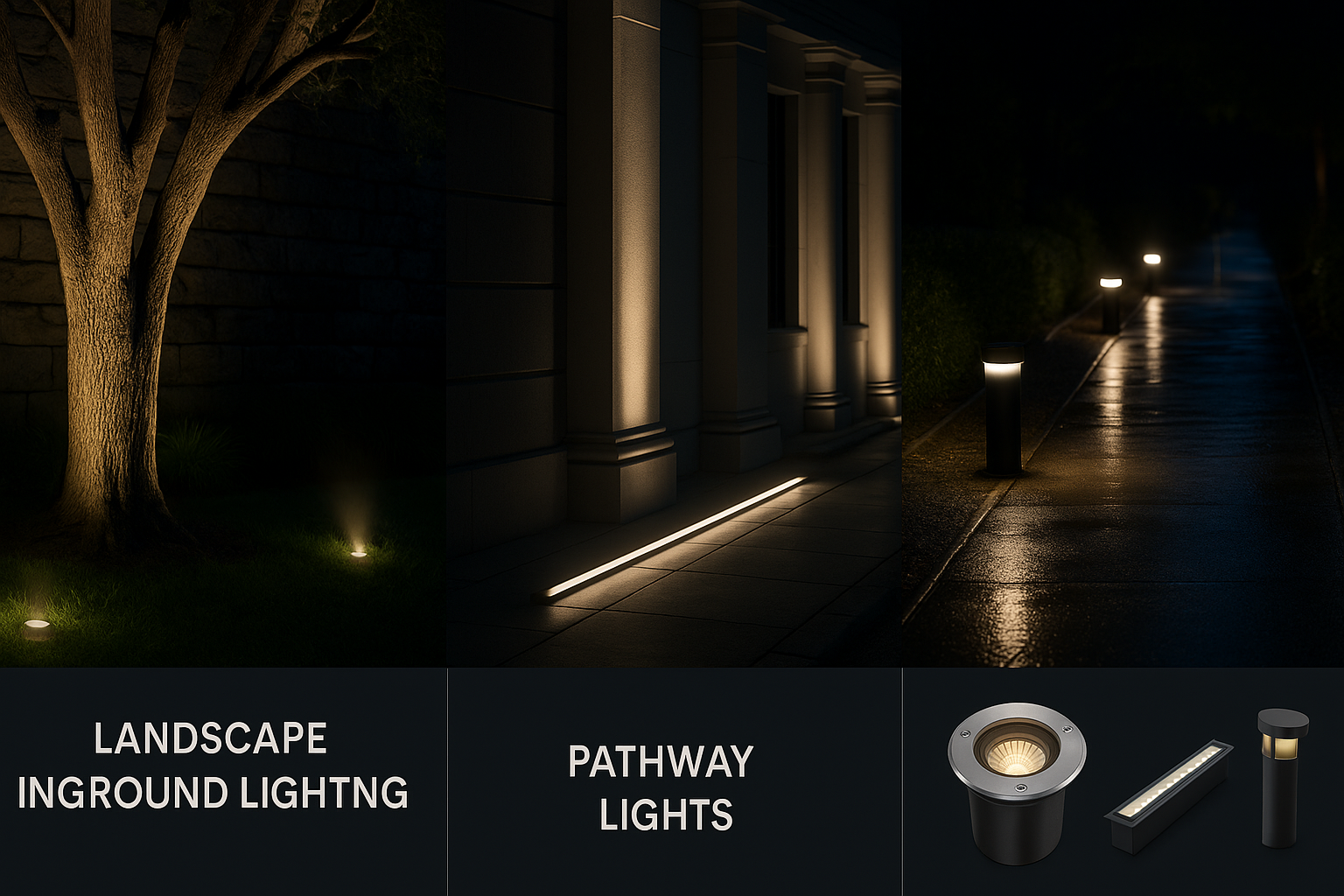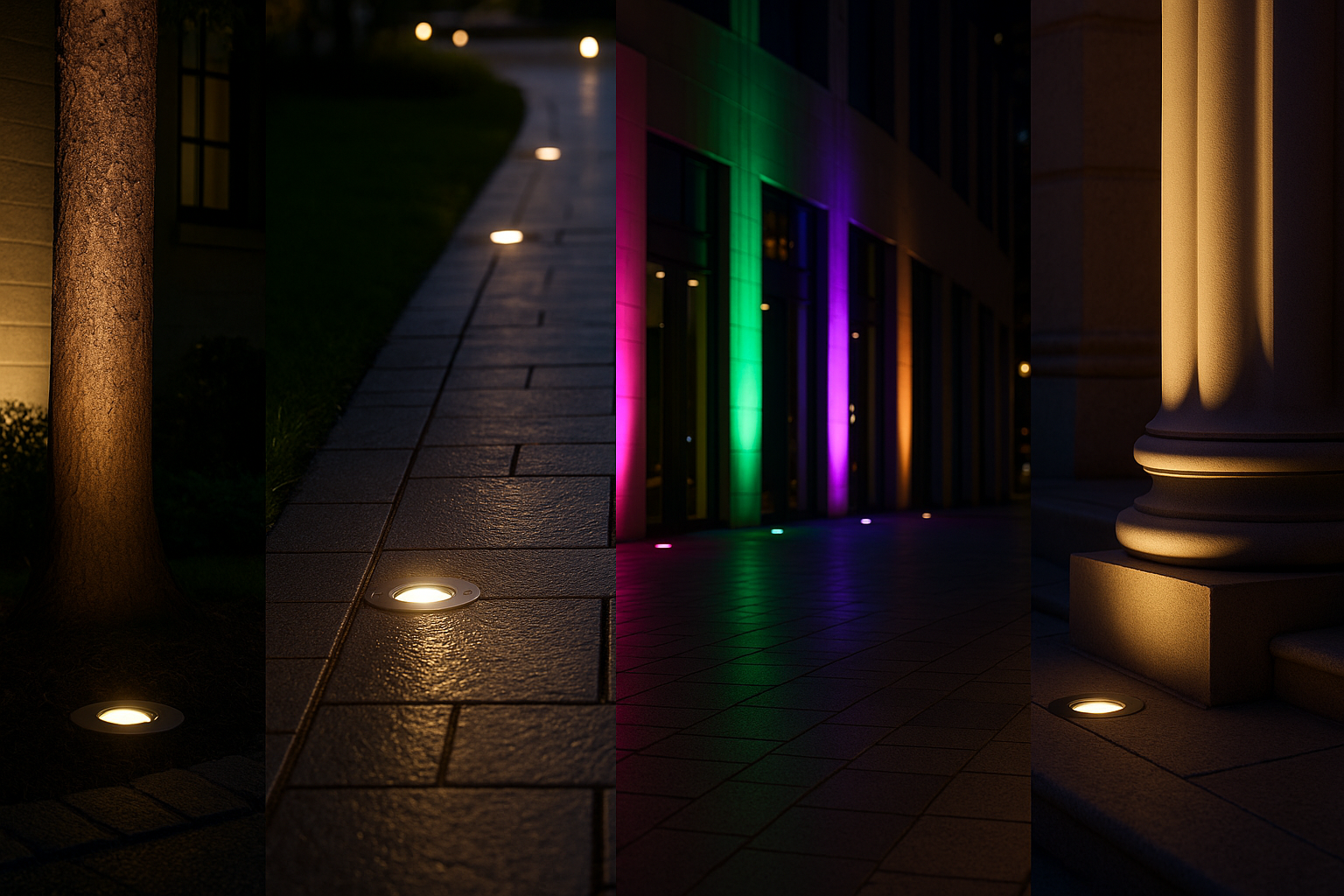Blog
Landscape Inground Lighting
When landscape inground lighting fails, it’s a costly mess. Here’s what spec-savvy buyers demand before lighting up 200+ fixtures.
You ever notice how some outdoor spaces just hit different at night? That’s not an accident—it’s all in the lights. Landscape inground lighting isn’t just a fancy way to say “lights in the ground.” It’s how parks, plazas, and posh driveways go from basic to breathtaking after dark. But here’s the kicker: when those fixtures fail—flooded housings, cracked lenses, dim-as-a-candle glow—it ain’t pretty. Especially if you’re footing the bill for 200 of ’em. Buyers want gear that lasts longer than a TikTok trend and doesn’t fry when it rains sideways.
Short answer? You need specs that work as hard as you do. IP67 waterproofing, IK10 impact resistance, LED chips with serious backbone—this stuff matters when you’re lighting up public walkways or high-traffic zones. According to Statista’s 2023 report on outdoor lighting demand in North America, commercial-grade installations have surged by over 22% in five years… so yeah, buyers aren’t playing around anymore.
Key Points That Shine: A Quick-Glance Guide to Landscape Inground Lighting
Fixture Types Matter: From recessed ground spotlights with high-power LED chips to RGB uplights, each fixture type serves a distinct role in enhancing outdoor environments.
Durability Is Non-Negotiable: IP67 waterproofing, IK10 impact resistance, and corrosion-resistant aluminum alloy are essential specs for long-term reliability in public zones.
Installation Enhancers: Drainage gravel bedding and waterproof junction boxes boost fixture stability and prevent water-related failures.
Lighting Goals Define Selection: Use directional flood lights for cool white illumination in parks or well light fixtures with tempered glass for architectural highlights.
Function vs. Form Distinction: Landscape inground lighting blends invisibly into terrain, while pathway lights offer visible guidance—both vital but purpose-driven.
Types Of Landscape Inground Lighting Fixtures
A quick guide to the coolest types of ground-level lighting that bring outdoor spaces to life after dark.

Application effects of different types of landscape inground lighting in nighttime environments
Recessed ground spotlights powered by high-power LED chips
- Recessed into the soil or concrete, these lights stay flush with the surface—no tripping hazards here.
- Built with high-power LED chips, they blast out serious brightness while sipping energy.
- Great for driveways, patios, and highlighting architectural textures.
You’ll often find these tucked around walkways or at the base of walls, where their sleek profile keeps things tidy. These ground spotlights are a favorite among pros for both safety and style. And since they’re part of the broader family of inground lighting, they blend right into your outdoor setup without stealing attention.
Directional flood lights for cool white illumination
• Aimed beams deliver focused light where it’s needed most
• The crisp cool white illumination is perfect for night visibility
• Ideal for showcasing trees, sculptures, or signage
These directional flood lights don’t just light up—they frame your space like an artist. Their adjustable heads let you point them exactly where you want. Whether it’s a city park or backyard garden, this type of inground lighting brings clarity and contrast in all the right places using targeted beams.
Pathway bollard lights in corrosion-resistant aluminum alloy
-
Group 1: Design Features
• Sleek vertical form adds modern flair
• Fits neatly along paths without clutter -
Group 2: Material Advantages
• Made from tough corrosion-resistant aluminum alloy
• Stands up to coastal air and rough weather -
Group 3: Functionality
• Glows softly to guide foot traffic
• Keeps areas safe without harsh glare
These sturdy little sentinels line your walkways with intention. Their build makes them reliable even when rain won’t quit. As part of your low-profile pathway lighting, bollards do more than glow—they define space with confidence.
Well light fixtures with tempered glass lens covers
The best thing about a good set of well lights? They vanish when off but shine hard when on. Set deep into planting beds or pavers, these fixtures come sealed tight beneath durable tempered glass lens covers, keeping out dirt and moisture like champs. You’ll see them used under trees or near water features where discreet uplighting matters most. As part of any serious outdoor plan involving embedded fixtures, this type fits squarely in the world of subtle yet effective inground lighting.
Uplight fixtures featuring RGB color-changing capability
1) Choose your mood—red for drama, blue for calm
2) Sync colors across multiple units via smart controls
3) Create dynamic scenes that shift throughout the evening
These aren’t just basic uplights—they’re vibe machines. With full-spectrum RGB tech baked in, these colorful powerhouses let you paint your yard however you like. Whether you’re spotlighting a sculpture or washing a wall in rotating hues, this kind of tech-driven fixture adds flair to any outdoor setting using flexible RGB-style uplight fixtures, making every night feel like an event.
Five Key Factors In Landscape Inground Lighting Durability
Smart outdoor lighting isn’t just about brightness—it’s about staying power. Here’s what keeps ground fixtures going strong in all conditions.

Durability design of high-quality inground lights ensures they work reliably in various harsh environments
IP67 waterproof rating: Protecting fixtures from water ingress
• Keeps out dust and heavy rain with a tight IP67 rating seal
• Ideal for wet environments like gardens and walkways
• Prevents internal short circuits caused by water ingress
- The fixture is completely sealed against solid particles like sand or soil.
- It can survive full immersion in water up to 1 meter deep for 30 minutes.
✓ This level of waterproof protection means you won’t have to worry about random puddles or sprinkler systems ruining your setup.
Outdoor lights live rough lives—rain, mud, even pressure washing—but with this kind of defense, your gear stays dry inside no matter what the outside throws at it.
How corrosion-resistant aluminum alloy prevents rusting
• Built using high-grade corrosion-resistant aluminum alloy
• Resists salt spray and acid rain in coastal or industrial zones
• Stops the slow creep of surface oxidation
Salt air? Acidic soil? No problem. These fixtures don’t flinch when the weather turns sour. The secret’s in the material science—aluminum alloys treated for max durability shrug off rust like it’s nothing.
Short-term looks are one thing, but long-term strength comes down to how well a light fights off corrosion. And these do it with style.
Can IK10 impact resistance withstand outdoor hazards?
You’ve got kids playing soccer nearby, heavy foot traffic, maybe even wildlife stomping through your yard at night. That’s where an IK10 rating steps up:
- Withstands impacts up to 20 joules—think dropped tools or kicked rocks
- Uses reinforced housings and toughened glass or polycarbonate lens
- Built for public spaces where vandalism is a real concern
“According to the 2024 Outdoor Fixture Safety Index by LumaTech Research, IK10-rated enclosures reduce maintenance costs by over 35% annually due to fewer breakages.”
That’s not just tough—it’s smart protection where it matters most.
Why low thermal resistance design extends LED lifespan
LEDs hate heat—and if it’s not handled right, their output fades fast. That’s why smart lighting designs focus on minimizing thermal resistance, keeping junction temps low and performance high.
| Component | Heat Transfer Efficiency | Lifespan Impact | Cooling Mechanism |
|---|---|---|---|
| Copper PCB | High | +25% | Direct conduction |
| Aluminum housing | Moderate | +15% | Passive dissipation |
| Plastic casing | Low | -30% | Poor dissipation |
| Ceramic base | Very High | +40% | Thermal isolation zone |
When heat flows out efficiently through proper materials—like a solid heat sink—you get more hours of bright light without burnout or sudden dimming.
And that means fewer replacements and better value over time.
How drainage gravel bedding enhances fixture stability
Group A – Water Management:
• Proper layers of drainage gravel allow water runoff instead of pooling around fixtures
• Reduces pressure buildup that could shift placement during storms
Group B – Structural Support:
• Helps prevent fixture tilt due to softening soil or freeze-thaw cycles
• Acts as a buffer against minor ground movement caused by foot traffic
Group C – Installation Benefits:
• Easier leveling during initial setup thanks to flexible bedding layer
• Reduces long-term maintenance needs linked to shifting foundations
Without this under-layer support system, even rugged lights can end up crooked—or worse, submerged after heavy rains. Gravel may seem basic, but it’s doing serious work behind the scenes keeping those units upright and dry.
In short? Don’t skip the base prep—it’s what makes everything else last longer above ground.
Landscape Inground Lighting Vs Pathway Lights
A quick dive into how two types of outdoor lighting stack up—what they do best, where they shine, and how to choose between them.

Comparison of application scenarios: Landscape inground lighting (left) vs pathway lights (right)
Landscape inground lighting
- Uplighting from in-ground fixtures gives trees and architectural details a dramatic pop at night.
- These lights are usually recessed fixtures, meaning they’re flush with the ground and don’t get in the way.
- They’re built for the long haul—expect serious durability and weather resistance, even during harsh winters.
- Great for highlighting vertical surfaces like walls or statues.
- Installed beneath the surface, they keep your yard sleek and clutter-free.
- Often used with narrow beam angle optics to focus light upward.
• Maintenance is low once installed, but cleaning lens covers helps keep brightness consistent.
These lights work best when you want that “hidden source” effect—where you see the glow but not the fixture itself.
Short bursts of light can create visual drama; perfect for spotlighting a tree trunk or casting shadows on textured stonework.
To install:
Step 1: Dig out a small trench or pit for housing the fixture.
Step 2: Wire it using appropriate waterproof connectors.
Step 3: Backfill carefully to avoid damaging wiring or alignment.
Step 4: Test angles before finalizing position.
Grouped uses include:
- Accent lighting under shrubs
- Wall-washing effects on facades
- Tree base uplighting with wide spreads
By tucking sources underground, you’re letting your space breathe while still showcasing its best features after dark. The trick lies in combining subtlety with strength—and these lights nail both.
Pathway lights
• These are all about visibility—guiding footsteps along walkways while adding curb appeal at night.
1) Most run on low voltage, making them safer to install around gardens or near water features.
2) Some models are fully solar powered, which means no digging trenches or messing with wiring.
3) You’ll find tons of different fixture styles, from lanterns to modern bollards.
– They’re often spaced evenly for consistent path illumination without glare.
– Ideal spacing? About every 6–8 feet depending on output strength and beam spread.
Pathway lighting isn’t just practical—it’s got style too. With so many designs available, it’s easy to match them to your home’s vibe.
Quick-use cases:
• Marking edges of driveways
• Illuminating garden paths
• Adding ambiance near patios
Here’s how people typically use them:
Group A – Decorative + functional (e.g., copper lanterns lining flower beds)
Group B – Motion-sensor safety setups near stairs or slopes
Group C – Mixed-use arrays that blend path lighting with accent glows
Unlike recessed uplights that disappear into lawns, these guys stand tall—or at least visible—making their presence part of your yard’s personality.
Both types have their perks, but if you’re aiming for safety plus some flair along footpaths, pathway options take the cake every time—even if landscape-style options like those from MG Lighting bring more drama elsewhere in your yard.
FAQs about Landscape Inground Lighting
What makes inground lighting a smart choice for outdoor commercial spaces?
It’s all about blending strength with subtlety. These fixtures are built to disappear into the environment while delivering powerful illumination. You get:
- High-efficiency LED chips that cut energy costs without sacrificing brightness
- IP67 waterproofing—because rain doesn’t cancel business hours
- Aluminum alloy housing that shrugs off rust and corrosion like it’s nothing
- Optional RGB color modes for when you want your space to speak in color, not just light
How does gravel bedding help these lights last longer?
Picture this: water pooling around your ground lights after every storm, slowly wearing them down from the base up. That’s where drainage gravel comes in—it acts like a natural buffer zone, letting moisture escape instead of linger. It keeps things dry beneath the surface, so your fixtures stay steady and strong through every season.
Are well lights tough enough for crowded public areas?
Absolutely—and not just by accident. These units come armored with tempered glass lenses and IK10 impact ratings, which means they can take on foot traffic, rogue shopping carts, or even an occasional soccer ball without flinching.
Why should I care about thermal resistance in LED inground lighting?
Because heat is silent sabotage. Without proper dissipation:
- LEDs dim faster over time
- Internal components wear out before their time
But when thermal resistance is low (which is good), heat escapes efficiently—keeping brightness consistent and extending lifespan dramatically.
Can bollard lights replace inground options entirely?
Not quite—they serve different moods and functions. Bollards stand tall to guide paths clearly; they’re visual markers as much as light sources. Inground fixtures tuck away discreetly into hardscapes or lawns, casting upward glows that highlight architecture or trees without stealing attention themselves.
Each has its place—but if you’re chasing elegance underfoot rather than overhead guidance, stick with ingrounds.




